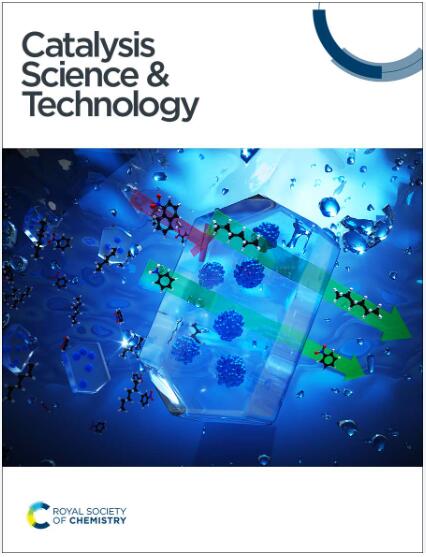Partial framework-Al in lamellar H-[Al]-RUB-18: acidity by probe TMPO adsorption and catalytic study in the presence and absence of water†
IF 4.4
3区 化学
Q2 CHEMISTRY, PHYSICAL
引用次数: 0
Abstract
While framework-Al (AlTd) sites on [Al]-RUB-18 materials with Brønsted acidity were active in ethanol dehydration, the acidity of partial framework-Al sites (AlOh or aluminol sites) remains unknown. 31P-MAS-NMR of adsorbed trimethylphosphine oxide (TMPO) was used together with catalytic reactions, in the presence and absence of water, to elucidate the acidity features of aluminol sites on lamellar RUB-18. Herein, spectroscopic analysis indicates that the 31P signals arise from TMPO adsorbed on the lamella surface of RUB-18 (δ31P = 40–49 ppm), silanol/aluminol sites (δ31P = 49–56 ppm), and Brønsted acid sites (60–75 ppm). The crystallinity degree of the structure, Si/Al and AlTd/AlOh molar ratios, and TMPO loadings, under wet and dry conditions, all lead to changes in 31P resonances. Two resonance signals at 64 ppm and 69 ppm were attributed to partial and complete framework-Al sites, respectively. A clear correlation between the adsorption capacity of the active sites and peak intensities in the BAS region proves the influence of water in the adsorption process. This study brings additional evidence that the (SiO4)4Al and (SiO4)3Al–(OH)(H2O)2 species played a crucial role in biomass-derivative conversion reactions. The simultaneous activity of Brønsted/Lewis acid sites was revealed, with the possibility of the (SiO4)3Al–(OH)(H2O)2 sites acting as LAS. The present study clarifies the acidity features of aluminol sites on lamellar [Al]-RUB-18 and brings attention to the evaluation of solid catalysts under aqueous-phase conditions.

层状H-[Al]- rub -18中部分框架Al:存在和不存在水时探针TMPO吸附和催化研究的酸性
虽然Brønsted酸性[Al]-RUB-18材料上的框架-Al (AlTd)位点在乙醇脱水中具有活性,但部分框架-Al位点(AlOh或铝醇位点)的酸性尚不清楚。利用吸附氧化三甲基膦(TMPO)的31P-MAS-NMR和催化反应,在有水和无水的情况下,阐明了层状RUB-18上铝醇位点的酸性特征。光谱分析表明,31P信号来源于吸附在RUB-18薄片表面的TMPO (δ31P = 40 ~ 49 ppm)、硅醇/铝醇位点(δ31P = 49 ~ 56 ppm)和Brønsted酸位点(60 ~ 75 ppm)。在干湿条件下,结构的结晶度、Si/Al和AlTd/AlOh的摩尔比以及TMPO的负载都会导致31P共振的变化。两个共振信号在64 ppm和69 ppm分别归因于部分和完整的框架-铝位点。活性位点的吸附容量与BAS区峰值强度之间存在明显的相关性,证明了水在吸附过程中的影响。该研究进一步证明了(SiO4)4Al和(SiO4)3Al - (OH)(H2O)2在生物质衍生物转化反应中起着至关重要的作用。Brønsted/Lewis酸位点同时具有活性,可能是(SiO4)3Al - (OH)(H2O)2位点作为LAS。本研究阐明了层状[Al]-RUB-18上铝醇位点的酸性特征,并关注了水相条件下固体催化剂的评价。
本文章由计算机程序翻译,如有差异,请以英文原文为准。
求助全文
约1分钟内获得全文
求助全文
来源期刊

Catalysis Science & Technology
CHEMISTRY, PHYSICAL-
CiteScore
8.70
自引率
6.00%
发文量
587
审稿时长
1.5 months
期刊介绍:
A multidisciplinary journal focusing on cutting edge research across all fundamental science and technological aspects of catalysis.
Editor-in-chief: Bert Weckhuysen
Impact factor: 5.0
Time to first decision (peer reviewed only): 31 days
 求助内容:
求助内容: 应助结果提醒方式:
应助结果提醒方式:


